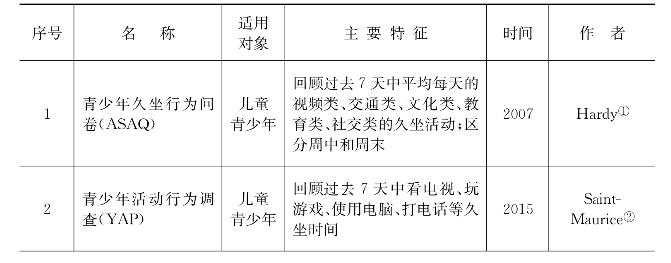
能量消耗水平是国际普遍认可的久坐行为评判标尺,MET是能量消耗的表征性指标,被采用作为评测久坐行为的参考依据,以ActiGraph为代表的加速度计使得对MET客观性地测量与评价成为可能。但是,加速度计的使用成本和数据采集效率仍是阻碍大范围久坐行为流行性普查的现实问题。反之,久坐行为量表/问卷则是可操作性更强、适用人群更广泛的研究工具,但这类主观性测评往往反映的问题是工具信度较高,但是效度可能不够理想[28][29]。能否准确识别久坐行为是工具选择的主要依据,但由于久坐行为具体情况的差异性不可避免地会导致测量与评价存在一定程度的误读。比如,加速度计可以客观地测定人们身体活动和久坐行为,但是客观性数据本身无法区别久坐行为的类型,而阅读、看电视或是开车等不同久坐行为是否存在健康危害的差异性还不得而知;比如,客观性数据无法识别被试人群所处的气候环境、文化习俗以及久坐状态等特征,而这些因素势必会潜移默化地影响着人们的日常活动行为。这些优劣特点与身体活动水平主客观评测工具的问题如出一辙[30]。由此来看,客观性与主观性久坐行为评测工具相结合的使用,可能仍然是未来的发展趋势。然而,相比于屏幕时间带来肥胖、慢性心血管疾病风险所不同,Bavishi[31]发现阅读是唯一与积极的健康指标始终正向关联的久坐类型,但是当今基于电子书与纸质书阅读的久坐行为对健康影响是否存在差异,也尚不清楚。此外,随着智能手机和网络流媒体“泛滥式”地快速普及和增长,久坐行为问卷也需要将智能手机网上娱乐等新型的久坐行为纳入其中。值得注意的是,相比于加速度计等客观性测评工具,自填式调查问卷获取的久坐行为数据反映了与健康结果更强的相关性,对儿童青少年则更为明显[32][33]。可能因为客观性方法测得的是包含屏幕、阅读、交通各类久坐行为的总体时间,没能区分久坐类型,而主观性工具可以获得诸如屏幕时间的某类久坐行为,而屏幕时间已被证实了与慢性疾病之间的密切关系,比其他久坐类型的健康危害可能更为明显。
通过梳理国际上常用的久坐行为调查问卷(见表5.3),发现存在几个主要特征:①“看电视”“使用电脑”和“总体屏幕时间(包括看电视/电影,使用电脑娱乐或做功课)”是最广泛被调查的久坐类型,而阅读和交通出行的静坐时间则较少有问卷涉及;②无论是青少年还是成年久坐行为的调查,大多都将周一至周五的“周中时间”与“周末时间”区分开来,关注到了两者之间生活作息状态的差异;③回顾式问卷的时间跨度较大,包含了过去的24小时、3天、7天、甚至12个月的较大差异,兼顾久坐时间数据的准确性和稳定性是需要注意的要点;④年龄差异导致无法正确评估自身久坐行为的问题仍在没有解决,对于儿童青少年尤其如此,避免过度填报和重复填报的引导性措施不够充分;⑤问卷信效度不尽相同,不同特征群体的差异较大,总体上适用于儿童青少年和成人久坐行为的调查,但结合客观性测量方式更佳;⑥SITBRQ从每小时“休息频率”和“休息时长”的角度,反观日常工作中的久坐行为,而iHSQ则重点关注了校外期间的久坐行为,都提供了新的研究思路。
表5.3 儿童青少年与成人久坐行为调查问卷一览

①Hardy L,Booth M L,Okely A D.The reliability of the adolescent sedentary activity questionnaire(ASAQ).Preventive Medicine,2007,45(1):71-74.
②Saint-Maurice P F,Welk G J.Validity and calibration of the Youth Activity Profile[J].PLoS ONE,2015,10(12):e0143949.
(续表)

①Strugnell C,Renzaho A,Ridley K.Reliability of the modified child and adolescent physical activity and nutrition survey,physical activity(CAPANS-PA)questionnaire among chinese-australian youth[J].BMC Med Res Methodol,2011,11(1):122.
②Leatherdale S T,Laxer R E,Faulkner G E.Reliability and validity of the physical activity and sedentary behaviour measures in the COMPASS studyp[J].COMPASS Technical Report Series,2014,2(1):1-21.
③Cerin E,Sit Chp,Huang Y-J,et al.Repeatability of self-report measures of physical activity,sedentary and travel behaviour in Hong Kong adolescents for the iHealt(H)and IPEN-Adolescent studies[J].BMC Pediatr,2014,14:142.
④Chinapaw M J.Reliability and validity of the activity questionnaire for adults and adolescents(AQu AA)[J].BMC Medical Research Methodology,2009,9.
⑤Matthews C E,Keadle S K,Sampson J,et al.Validation of a previous-day recall measure of active and sedentary behaviors[J].Medicine&Science in Sports&Exercise,2013,45(8):1629-1638.
⑥IPAQ.Guidelines for data processing and analysis of the international physical activity questionnaire(IPAQ)-short and long forms,revised on November 2005[EB/OL].www.ipaq.ki.se/scoring,2005.
⑦Marshall A L,Miller Y D,Burton N W,et al.Measuring total and domain-specific sitting:A study of reliability and validity[J].Medicine&Science in Sports&Exercise,2010,42(6):1094- 1102.
(续表)

①Pedisic Z,Bennie J,Timperio A,et al.Workplace sitting breaks questionnaire(SITBRQ):an assessment of concurrent validity and test-retest reliability[J].Bmc Public Health,2014,14(1):1249.
②Lynch B M,Friedenreich C M,Khandwala F,et al.Development and testing of a past year measure of sedentary behavior:the SIT-Q[J].BMC Public Health,2014,14.
③Wijndaele K,De Bourdeaudhuij I,Godino J G,et al.Reliability and validity of a domain-specific last 7- d sedentary time questionnaire[J].Medicine&Science in Sports&Exercise,2014,46(6):1248-1260.
④Chau J Y,Van D P H P,Dunn S,et al.Validity of the occupational sitting and physical activity questionnaire[J].Medicine&Science in Sports&Exercise,2012,44(1):118-125.
⑤Clark B K,Winkler E,Healy G N,et al.Adults'past-day recall of sedentary time[J].Medicine&Science in Sports&Exercise,2013,45(6):1198-1207.
⑥Rosenberg D E,Norman G J,Wagner N,et al.Reliability and validity of the sedentary behavior questionnaire(SBQ)for adults[J].Journal of Physical Activity and Health,2010,7(6):697-705.
⑦Shuval K,Kohl H W,Bernstein I,et al.Sedentary behaviour and physical inactivity assessment in primary care:the rapid assessment disuse index(RADI)study[J].British Journal of Sports Medicine,2014,48(3):250- 255.
(续表)

①Gardiner P A,Clark B K,Healy G N,et al.Measuring older adults'sedentary time:reliability,validity,and responsiveness[J].Med Sci Sports Exerc,2011,43(11):2127-2133.
②Visser M,Koster A.Development of a questionnaire to assess sedentary time in older persons-a comparative study using accelerometry[J].Bmc Geriatrics,2013,13(1):80.
笔者在2018年年底赴剑桥大学参加了ISPAH(International Society of Physical Activity and Health,ISPAH)组织的“久坐行为影响机制”学术研讨会,WHO(Fiona Bull)、加拿大(Mark S Tremblay、Ian Janssen),澳大利亚(Stuart Biddle、Neville Owen)……国际组织和国家身体活动与久坐行为指南的研制者和负责人共同探讨了针对不同特征人群,建立从幼儿到成人乃至特殊人群全覆盖的久坐行为建议标准。随着知识体系的不断完善和健康危害的逐渐明确,久坐行为流行病学也继身体活动流行病学[34]之后渐渐成为新的研究热点。我国儿童青少年久坐时间低于2小时/天的比例仅为11.8%[35],且“中国特色”式的家庭作业静坐时间是最为突出的久坐类型,远大于休闲娱乐的屏幕时间[36]。基于本土实际的久坐行为研究,我国广大学者们仍是任重道远。
久坐行为可能被复杂交错的多重因素所影响,其活动行为需要在个人、学校、家庭、社会、环境和政策等多个层面来审视,而这些影响因素与久坐行为之间往往可能是非线性的复杂关系,个体的活动行为与生存状态、社会舆论、政策环境等交织在一起因而不容易被识别。然而,当前对于久坐行为的评测多是运用横断面研究的方法,强调在统计方法上进行推算和预测,但可能无法识别多重因素与久坐行为之间的复杂关系,所以通过群体干预和政策引导等单一方式自然也无法获得减少久坐行为的持续性效果,而是需要将健康意识的提升和积极行动的推动融入日常生活方式的改善过程。同时,通过长时跟踪研究识别日常久坐时间分布的稳定状态以及影响因素之间“决定性”的关系。
无论是青少年学生的读书、作业,还是成人的工作、社交,长时间静坐是不可避免的生活状态,关键在于如何找到身体活动与久坐行为之间的平衡。那么,我国久坐行为研究可能还有待解决的问题和寻求发展的方向在于:①形成体医结合的跨学科合作的研究队伍,厘清久坐的行为学表现与医学的健康风险之间的关系;②加强各个特征群体的实验性实证研究,明确久坐行为与健康危害的剂量关系,提升建议指导的科学性、准确性;③展开久坐行为作为慢病独立风险因素的持续探索,重新审视与身体活动的关系;④结合学业压力和屏幕时间的本土“特色”,研制久坐行为测量与评价的研究工具。2018年,WHO组织发布了《全球身体活动行动计划》,目标到2025年将全球身体活动不足的比例下降10%[37],在此过程中,我国学者应抓住机会,为学科发展提供原创性的贡献,从而切实为儿童青少年乃至成年人健康发展提供有价值的决策依据。
【注释】
[1]Baddeley B,Sornalingam S,Cooper M.Sitting is the new smoking:where do we stand?[J].British Journal of General Practice,2016,66(646):258.
[2]Nilay Suth.Sitting is the new smoking:is there a“NEAT DEFECT”?[J].Journal of Medical Sciences,2014,3(2):5-6.
[3]Sedentary Behaviour Research Network.Letter to the Editor:Standardized use of the terms“sedentary”and“sedentary behaviours”[J].Applied Physiology,Nutrition,and Metabolism,2012,37(3):540-542.
[4]Tremblay M S,SaloméAubert,Barnes J D,et al.Sedentary Behavior Research Network(SBRN)—Terminology Consensus Project process and outcome[J].International Journal of Behavioral Nutrition&Physical Activity,2017,14(1):75.
[5]Tudor-Locke C,Craig C,Thyfault J P,et al.A step-defined sedentary lifestyle index:<5 000 steps/day[J].Appl.Physiol.Nutr.Metab,2013,38:100-114.
[6]Craig C L,Cameron C,Griffiths J M,et al.Descriptive epidemiology of youth pedometer-determined physical activity:CANPLAY[J].Med.Sci.Sports Exerc,2010,42(9):1639-1643.
[7]Viir R,VeraksitšA.Discussion of“letter to the editor:standardized use of the terms sedentary and sedentary behaviours”—sitting and reclining are different states[J].Applied Physiology,Nutrition,and Metabolism,2012,37(6):1256.
[8]Carson V,Hunter S,Kuzik N,et al.Systematic review of sedentary behaviour and health indicators in schoolaged children and youth:an update[J].Applied Physiology,Nutrition,and Metabolism,2016,41(6 Suppl 3):S240-S265.
[9]Biswas A,Oh Pi,Faulkner Ge,et al.Sedentary time and its association with risk for disease incidence,mortality,and hospitalization in adults:a systematic review and meta-analysis[J].Annals of Internal Medicine,2015,162(2):123-132.
[10]Caspersen CJ,Powell K E,Christenson G M.Physical activity,exercise,and physical fitness:definitions and distinctions for health-related research[J].Public health reports,1985,100(2):126.(www.xing528.com)
[11]European Opinion Research Group.Physical activity[R].Special Eurobarometer 183-6/Wave 58.2,2003.
[12]HEPA EUROPE.European network for the promotion of health-enhancing physical activity[R].Copenhagen:WHO Regional Office for Europe,2005.
[13]Levine J,Melanson E L,Westerterp K R,et al.Measurement of the components of nonexercise activity thermogenesis[J].Am J Physiol Endocrinol Metab,2001,281(4):E670.
[14]郭强.中国儿童青少年身体活动水平及其影响因素的研究[D].华东师范大学,2016.
[15]Smith A L,Biddle S.Youth physical activity and sedentary behavior:challenges and solutions[M].Champaign:Human Kinetics,2008:6- 8.
[16]国家体育总局.2014年全民健身活动状况调查公报[EB/OL]http://www.sport.gov.cn/n16/n1077/n297454/7299833.html.2015- 11- 16.
[17]U.S.Department of Health and Human Services.Physical Activity Guidelines for Maericans,2nd edition[R].Washington DC:U.S.,2018.
[18]Hallal P C,Andersen L B,Bull F C,et al.Global physical activity levels:surveillance progress,pitfalls,and prospects[J].Lancet 2012,380(9838):247-257.
[19]郭强,汪晓赞.我国儿童青少年身体活动与久坐行为模式特征的研究[J].体育科学,2017,37(7):17-29.
[20]Pate R R,Mitchell J A,Byun W.Sedentary behaviour in youth[J].British Journal of Sports Medicine,2011,45:906-913.
[21]Remblay M S,Leblanc A G,Kho M E,et al.Systematic review of sedentary behaviour and health indicators in school-aged children and youth[J].International Journal of Behavioral Nutrition and Physical Activity,2011,8:9.
[22]Public Health Institute.Recommendations for physical activity[R].Reykjavík:Public Health Institute,2008.
[23]Titze S,Ring-Dimitriou S,Schober P H,et al.Austrian recommendations for health-promoting physical activity[R].Wien:Bundesministerium für Gesundheit,GesundheitÖsterreich Gmb H,Geschäftsbereich Fonds GesundesÖsterreich,2010.
[24]中国疾病预防控制局.中国成人身体活动指南(试行)[M].北京:人民卫生出版社,2011:1- 62.
[25]World Health Organization.Global recommendations on physical activity for health[R].Geneva:World Health Organization,2010.
[26]Stamatakis E,Ekelund U,Ding D,et al.Is the time right for quantitative public health guidelines on sitting?A narrative review of sedentary behaviourresearch paradigms and findings[J].British Journal of Sports Medicine,2018,0:1-8.
[27]Ekelund U,Steene-Johannessen J,Brown W J.Does physical activity attenuate,or even eliminate,the detrimental association of sitting time with mortality?A harmonized meta-analysis of data from more than 1 million men and women[J].Lancet,2016,388:1302-1310.
[28]Atkin,Andrew J,Gorely,et al.Methods of Measurement in epidemiology:Sedentary Behaviour[J].International Journal of Epidemiology,2012,41(5):1460-1471.
[29]Prince S A,Leblanc A G,Colley R C,et al.Measurement of sedentary behaviour in population health surveys:a review and recommendations[J].Peerj,2017,5(6):e4130.
[30]郭强,汪晓赞.儿童青少年身体活动研究的国际发展趋势与热点解析——基于流行病学的视角[J].体育科学,2015(7):58-73.
[31]Bavishi A,Slade M D,Levy B R.A chapter a day:association of book reading with longevity[J].Social Science and Medicine,2016,164:44-48.
[32]Arson V,Hunter S,Kuzik N,et al.Systematic review of sedentary behaviour and health indicators in school-aged children and youth:an update[J].Applied Physiology,Nutrition,and Metabolism,2016,41(6 Suppl 3):S240-S265.
[33]Cliff D P,Hesketh K D,Vella S A,et al.Objectively measured sedentary behaviour and health and development in childrenand adolescents:systematic review and meta-analysis[J].Obesity Reviews,2016,17(4):330-344.
[34]Caspersen,Carl J.Physical activity epidemiology[J].Exercise and Sport Sciences Reviews,1989,16:423-474.
[35]张加林,唐炎,陈佩杰,等.全球视域下我国城市儿童青少年身体活动研究——以上海市为例[J].体育科学,2017,37(1):14-27.
[36]郭强,汪晓赞.我国儿童青少年身体活动与久坐行为模式特征的研究[J].体育科学,2017,37(7):17-29.
[37]World Health Organization.Global action plan on physical activity 2018-2030:more active people for a healthier world[R].Geneva:World Health Organization,2018.
免责声明:以上内容源自网络,版权归原作者所有,如有侵犯您的原创版权请告知,我们将尽快删除相关内容。




